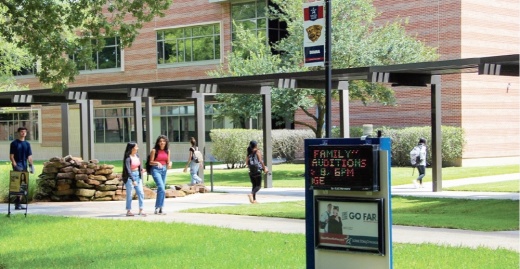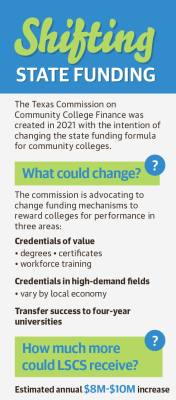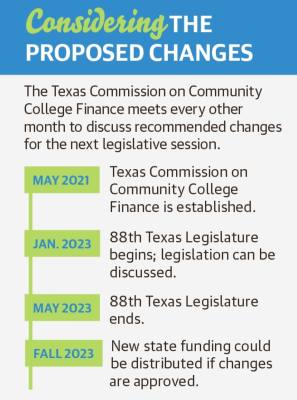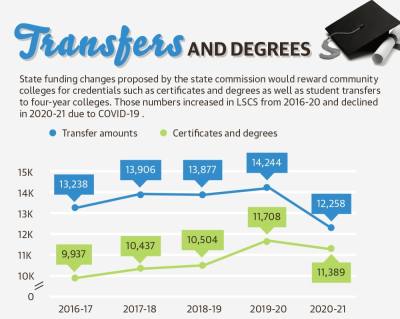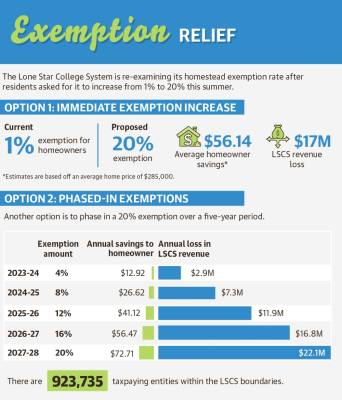Going into the 88th Texas legislative session in 2023, the state may shift from focusing on enrollment to student outcomes in determining funding for colleges.
Information from the Texas Commission on Community College Finance indicates 65% of 5,000 respondents to a July and August survey by the Texas Higher Education Coordinating Board are in favor of changing the state funding to be outcome based.
LSCS Chancellor Stephen Head, who serves on the commission, said there could be an $8 million to $10 million increase in funding for LSCS by fall 2023 if the changes are approved.
“What is driving this is a disparity gap between a number of community colleges,” Head said.
The final proposed changes are anticipated to be presented to the Legislature in November, and Head said he and the commission are optimistic it could pass in the next session.
Meanwhile, LSCS is considering increasing its homestead exemption after area residents spoke out regarding the rates during budget workshops, a change that could cost millions in annual tax revenues.
Outcome-based funding
Community colleges receive $1.3 million for core operations with additional funding available based on factors such as the number of student contact hours, or hours of scheduled instruction, according to Dallas-based nonprofit Texas 2036.
Data shows LSCS has seen a decrease in both its systemwide student headcount and contact hours since 2017 with enrollment dropping from 89,319 to 85,164 and contact hours decreasing from 11.9 million to 11 million.
LSCS budget documents also indicate tuition revenue declined following fiscal year 2019-20, dropping from $130 million to $124 million in fiscal year 2022-23.
A Sept. 12 presentation from the Texas Commission on Community College Finance stated there is demand to align funding with three major outcomes: credentials of value, credentials in high-demand fields and transfer success.
Head said he believes the changes will provide greater benefits to the smaller community colleges. He added there is also a push to fund the economically and academically disadvantaged.
“We would benefit from that; ... 57% of students in our independent school districts are economically disadvantaged,” he said.
The LSCS will receive around 20% of its total revenue from the state, 29% from student tuition, 48% from local taxes and 3% from miscellaneous sources in FY 2022-23. Budget documents project state funding will total around $83 million for FY 2022-23, the same as the previous year.
Head said the additional proposed funding could be used for purposes such as hiring additional staff, opening new facilities or replacing revenue lost from increasing the homestead exemption if the board approves it.
Matthew Fuller, a professor of higher education leadership at Sam Houston State University, said he is largely in support of the changes.
“Every educational funding formula has winners and losers,” Fuller said. “Those community colleges who attract students that are perhaps less prepared for college, ... they have a little bit more of an uphill battle in terms of getting those students to completion.”
State angle
State Sen. Brandon Creighton, R-Conroe, is among the commission members working to bring the proposed changes to the 88th Legislature.
“Through prioritizing strategic outcomes for student and workforce needs, the entire Texas economy will benefit,” Creighton said.
Matt Olmstead, an independent researcher in the field of performance-based funding in higher education, said performance-based funding from the state has been in effect since 2012, making up around 10%-15% of the total funding provided to community colleges.
Olmstead said he is concerned how the guidelines will be laid out.
“What is implemented for one large urban community college system is the same metric as a small community college in East Texas,” he said.
Olmstead noted an unintended consequence of shifting to performance-based funding would be meeting individual institutional missions. He said larger community colleges may be at a slight disadvantage compared to smaller institutions as they will have to show they are completing the metrics rather than having a larger student body.
Examining exemptions
Another potential change for LSCS’ revenue sources would be increasing the property tax exemption permitted for district homeowners.
LSCS has a 1% or $5,000 exemption, whichever is higher, for homeowners within its boundaries. According to the Texas comptroller’s office, a homestead exemption removes part of the home’s value from taxation.
Texas allows up to a 20% exemption, and residents asked that the rate be increased to the maximum amount during a Sept. 8 board meeting. LSCS taxpayer Susan Scruggs said residents are feeling pressure from high appraisals and inflation.
“I am asking you folks to look into your budget and find out how you can do an exemption for the people who have supported you for so many years,” Scruggs said.
During the meeting, LSCS Chief Financial Officer Jennifer Mott provided information on a phased approach to increasing the exemptions over five years.
Mott said an immediate shift to a 20% exemption would mean $17 million less revenue based on an average home appraisal of $285,000, and the average taxpayer would save around $56.14 annually.
Head said the board will begin assessing the exemption increases in February, and changes to the exemption rate will need to be set by July 1.




